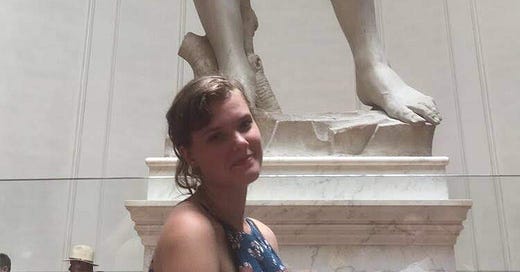In 2018, I had the opportunity to visit the Accademia Gallery in Florence, Italy, to see my favorite work of art in person. As you can perhaps see by my face, I could barely stop myself from crying in the presence of such a monumental work of art. Michelangelo’s David is colossal: seventeen feet of pure marble, carved into a man so lifelike that he almost seems to breathe. At the time, I was in the midst of reading The Agony and the Ecstasy by Irving Stone, and in the midst of a personal crossroads: the decision of whether to begin my graduate studies or to find a job. The David, along with Botticelli’s paintings Birth of Venus and Primavera, were works that have longstanding personal meaning to me: they are the works that ignited wonder in me as a child beyond comprehension.
When I first learned about the David and saw a photograph of it, I was convinced beyond doubt that it was a true rendering of the ancient King: I believed that God had guided Michelangelo’s hand to carve a true likeness of a king he never saw. It was the book of Samuel come alive—he stands so calmly, so confidently, as he faces Goliath. Moreover, and more importantly to me as a writer, when I looked at David, I could see his Psalms. Something in the way that Michelangelo portrays him creates this immediate connection between the statue and the mighty words of his psalms. Perhaps it is that he looks strong and mighty, yet soft to the touch—if I could lay my hand on the marble, I expect it would have the warmth of living skin.
“No man is born into the world whose work is not born with him.” Those words, buried in Michelangelo’s biography, haunted me that entire trip. He spent his whole life as a painter and a sculptor, and it was his work that ultimately took his life. He lived a life of constant pain, without comfort, due to the toll his work took on his body. Yet he worked, and he loved his work, and he believed that his work was God-given. He did what he believed God placed him on earth to do, and every scholar who has come after him can be confident he was right: his work has changed the world. His David, his Pieta, his Sistine Chapel are works of art that reveal the beauty of Scripture to believer and unbeliever alike.
I came home from that trip a changed person in many ways, perhaps most notably due to the effect Michelangelo’s work had on me. I have never carved anything and am certainly not a painter, but I have always written, whether it be poetry, prose, or an essay. Moreover, I have always felt born with that work within me: it is not a glamorous work, nor a glamorous life, five years later. I am at home, still physically recovering from pregnancy and birth, physically taxed by the work of my home and our land, and constantly occupied by caring for my son. Yet I was born to write, and I continue to write, if at a slower pace. Just this week I have begun teaching again, and with that comes the opportunity to read psalms and poems daily and to write and edit as I work with my students and teach them to do the same.
Imagine a world of Michelangelos: a world of men whose work reflects the Glory of God, and who triumph Truth, Beauty, and Goodness, even at great personal sacrifice. Imagine the poetry, the art, the music we would be surrounded with, the conversations we would have, and the churches we would get to see, beautifully decorated with the highest craftsmanship imaginable. This is how we should strive to raise our children, and to shape our communities and our priorities: around these virtues, using our talents all for the glory of God and the beautification of His House.
I would like to finish by sharing with you an episode of The Daily Poem, led by David Kern (which has just begun again, and is a great way for you to incorporate poetry into your everyday routine: Hannah listens to it while she does her dishes, I listen to it while driving). “Unfinished Madonna” is a poem written by Jill Kress Karn, a modern poet, inspired by one of Michelangelo’s carvings in the very same room as his David. She perfectly captures the awe of his work, and this poem has become one of my favorites because of it. Please enjoy her poem, and this photo of his Unfinished Madonna, taken by me in Florence, in 2018.
If you have been inspired by anything lately, please feel free to submit your work here on Mirabile Dictu! We would love for you to join our community by sharing the Truth, Beauty, and Goodness that you find wondrous to behold! Our community guidelines can be found here.







Amen. Your observations reminded me of Tolkien’s “On Fairy Stories.”
"[...] Although now long estranged,
Man is not wholly lost nor wholly changed.
Disgraced he may be, yet is not de-throned,
and keeps the rags of lordship once he owned:
Man, Sub-creator, the refracted Light
through whom is splintered from a single White
to many hues, and endlessly combined
in living shapes that move from mind to mind.
[...] (used or misused). That right has not decayed:
we make still by the law in which we're made."
"[W]e make in our measure and in our derivative mode, because we are made: and not only made, but made in the image and likeness of a Maker."